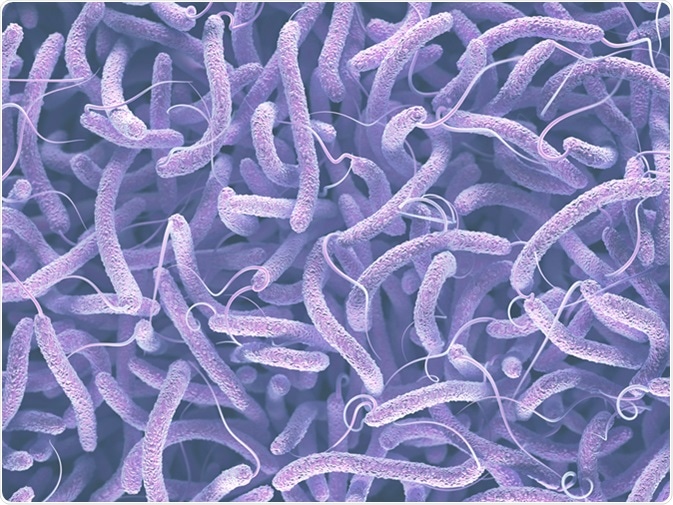Quorum sensing is a phenomenon in which bacteria can communicate with members of their own species and other species to coordinate their behavior. This phenomenon is achieved by the production and sensing of secreted signal molecules, which diffuse from the microbial cells and build up in the environment.
Quorum sensing allows for bacteria to coordinate responses to achieve many outcomes – including overwhelming the immune system, colonization of a host, and the production of toxins. Vibrio cholerae (V. cholerae) is a human pathogen that utilizes quorum sensing to colonize a host and produce its toxin.

Vibrio cholerae, Gram-negative bacteria. 3D illustration of bacteria with flagella. Image Credit: ktsdesign / Shutterstock
Quorum Sensing in Vibrio cholerae
Quorum signaling is controlled by two opposing pathways: the CqsS/CqsA pathway (produces and detects CAI-1), and the LuxS/LuxPQ pathway (produces and detects AI-2). CAI-1 and AI-2 are autoinducers which regulate quorum sensing in V. cholerae.
At low cell densities (i.e. low concentration of autoinducers), V. cholerae expresses virulence genes that allow this bacterial species to colonize the small intestine. This is achieved by CqsS and LuxQ activating LuxU. Once LuxU is activated it phosphorylates LuxO, which then activates transcription of four regulatory sRNAs (Qrr1-4). Qrr1-4 activate the transcription of AphA and inhibit the transcription of HapR. In addition, AphA induces the transcription of virulence genes.
At high cell densities, the autoinducers accumulate to high levels, which in turn inhibits the kinase activity of CqsS and LuxQ. This leads to the dephosphorylation and deactivation of LuxO, so transcription of Qrr1-4 stops and HapR is now produced instead of AphA. HapA is also activated at high cell densities and encodes for HA protease. In essence, HA protease is an extracellular protease that allows V. cholerae to detach from the intestine during colonization.
AphA and HapR are transcriptional regulators that regulate the expression of over 100 genes, some of which are involved in the colonization of the intestine and the production of toxins.
Quorum sensing: Bacteria talks | Bonnie Bassler
Vibrio cholerae pathogenesis
V. cholerae causes the development of an acute diarrheal illness known as cholera. To survive in the acidic environments of the stomach, V. cholerae assembles into a biofilm, which consists of the bacteria in a matrix of protein and sugars. LuxO activity promotes the formation of a biofilm; conversely, HapR activity suppresses it.
At low cell densities seen during initial colonization of a host, LuxO represses HapR so tcpP is expressed. This results in the expression of virulence factors that allow V. cholerae to colonize the small intestine, proliferate, and produce cholera toxin (CT).
Toxin-coregulated pili (TCP) are needed for the colonization of the intestine, as they mediate bacterial-bacterial adhesion, as well as bacterial-epithelial adhesion. The formation of TCPs is regulated by toxT, which acts to induce the transcription of TCP genes (such as tcpA-F and tcpl), as well as CT genes (such as ctxA and ctxB).
Transcription of toxT is regulated through the activity of TcpP, TcpH, ToxR, and ToxS receptors. TcpP is regulated by the actions of HapR. It is believed that HapR activates the transcription of a downstream repressor of tcpP expression. Therefore, TCP and CT genes are only transcribed at low cell densities.
A way towards clinical applicability
In conclusion, quorum sensing in V. cholerae is crucial for its survival in the harsh environments within the human stomach and gastrointestinal tract. It is responsible for producing proteins and structures involved in the colonization of a host, as well as the toxins that damage the host.
As quorum sensing in V. cholerae is not fully understood, more research is required to fill in the gaps. Hence, expanding our knowledge could allow for better treatments and preventative measures against V. cholerae infection.
Further Reading